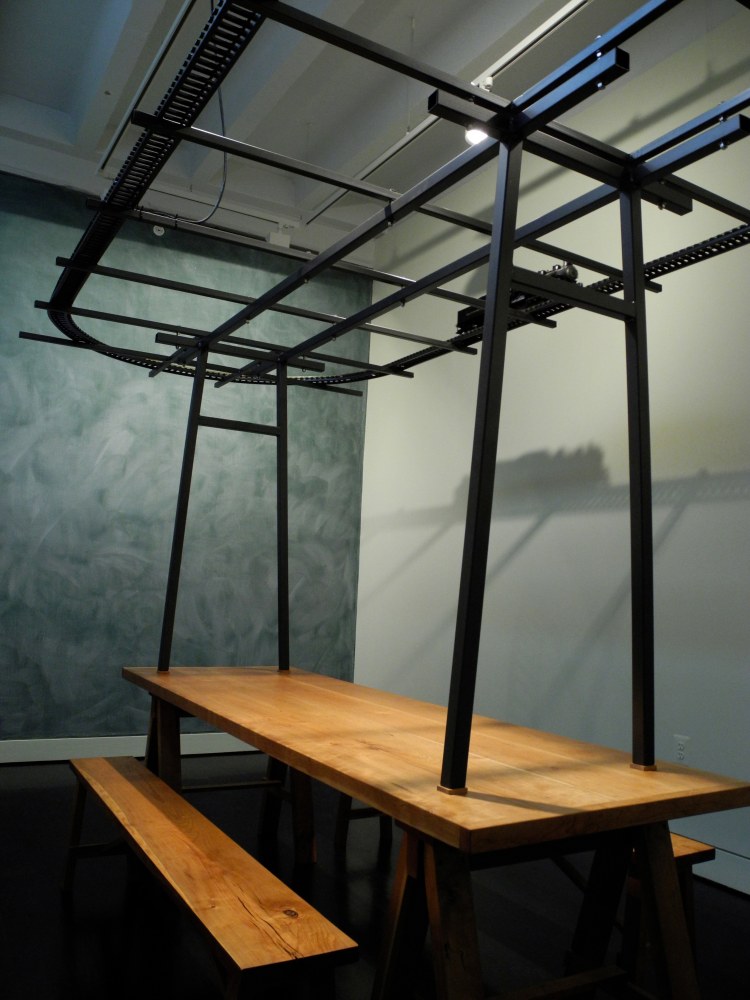
On a recent Wednesday afternoon, local artists Tom Ashcraft and Peter Winant hosted about a dozen people for lunch. The guests had responded to an open call to a bring-your-own-food “community meeting,” and most of them were fellow artists. The conversation was fairly heady, although not unprecedented on a stretch of 14th Street that’s home to many galleries and theaters.
The congenial, if slightly odd, event was rendered a little stranger by its setting: an elegantly constructed cherry-wood picnic table with a built-in loop of elevated model-railroad track. A three-car G-scale train trundled a few feet above the lunchers’ heads, as Ashcraft and Winant discussed Heidegger, ideation, go-go music and a project they’re planning for Haitian orphanages.
The venue was not some new theme restaurant, but Hemphill Fine Arts, the gallery now showing “Workingman Collective: Prospects and Provisions.” Along with Janis Goodman, Ashcraft and Winant are the core members of the collective, a local group that makes solid conceptual art. The word “makes” is important. Where most conceptual art is fleeting or purely theoretical, Workingman builds stuff to last.
The artists are fans of early-20th-century American craftsmanship and what Ashcraft calls the nation’s lost “age of optimism.” They have can-do spirit. But in the context of an art gallery, what exactly can they do with it?
The show opens with one of the trio’s more conventionally conceptual undertakings, “5 Mile Line.” The 2006 piece involved tracing red and blue chalk lines on the streets of Butte, Mont., following a 1914 map of seismic faults and mine tunnels beneath the city. All that remains of this undertaking are photographs of the lines and their making, plus the map and the team’s surveying tools.
Fitting conceptualism’s penchant for art that vanishes quickly, “5 Mile Line” leaves only documentation in its wake. Yet the big-sky setting and vintage map also reveal Workingman’s taste for the great outdoors and the good old days. At lunch, Ashcraft showed off a battered copy of one of his inspirations: a book titled “The Boy Mechanic: 1000 Things for Boys to Do,” originally published when Woodrow Wilson was president.
Conceptual art can overinvest in a single motif, and much of this show is devoted to another outdoorsy, old-timey icon: Lloyd “Trapper” Nelson’s wood-frame backpack, devised around 1924. There’s one of the originals (not for sale), a picture of the thing and seven immaculate replicas. Buy the piece titled “Provisions” (price available on request) and you’ll also get a sketchbook, a pencil and “consultation with Workingman Collective to plan and provision an expedition for the collector.”
Americans’ perspective on nature has changed since 1924 so, of course, the collective is interested in environmentalism as well as expeditions. One of the show’s biggest pieces, titled “Swing,” is just that. But the swaying two-sided bench, suspended from a steel frame, is arrayed with house plants that remove volatile organic compounds from the air. Those plants are watered from a rain barrel the artists placed in the alley behind the gallery building, attached to the gutters to collect precipitation that would otherwise flow into the local sewer system.
The group’s members are college-level art teachers — Goodman at the Corcoran, Ashcraft and Winant at George Mason University — with expertise in sculpture, drawing and printmaking. Yet they’re also experienced carpenters and contractors with an affinity for woodworking.
“We made everything here,” Winant says. Although sometimes making means repurposing: The rain barrel is a 55-gallon syrup container from a nearby Pepsi plant.
In a way, Workingman Collective is a build/design firm without a client. Perhaps that’s why its members seek collaborations with outsiders, including friends, kindred spirits and the potential collector who gets a consultation as part of the art.
The group’s motto is “your ideas are ours,” which Winant calls “a comment on the conceit of originality.” Ideas worth appropriating may arise at the gallery lunches, which will be hosted by one or more artists in the collective, and are open to all comers, every Wednesday at 1 p.m. until the show closes.
Marcel Duchamp, the godfather of conceptual art, also reused manufactured objects, but his “readymades” were not chosen for either aesthetic or practical value. The collective seems prepared to jettison (or at least play down) the former. “We quit asking if it’s art,” Ashcraft says. “Now we just ask, ‘Is it any good?’ ”
This sort of art can be good if it’s provocative or intriguing. Yet the collective remains keen on the functional: The swing swings, the train chugs and the rain barrel captures water. And the trio is planning to work in Haiti, a place with no pressing need for whimsy. The Workingman Collective artists may dabble in abstract or absurd ideas, but for them, it’s also important to be earnest.